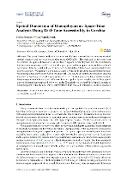Spatial Dimension of Unemployment: Space-Time Analysis Using Real-Time Accessibility in Czechia

Datum vydání
2020Publikováno v
ISPRS International Journal of Geo-Information [online]Ročník / Číslo vydání
9 (6)ISBN / ISSN
ISSN: 2220-9964Informace o financování
UK/PROGRES/Q44
GA0/GA/GA18-20904S
UK/UNCE/HUM/UNCE/HUM/018
Metadata
Zobrazit celý záznamKolekce
Tato publikace má vydavatelskou verzi s DOI 10.3390/ijgi9060401
Abstrakt
This paper focuses on the analysis of unemployment data in Czechia on a very detailed spatial structure and yearly, extended time series (2002-2019). The main goal of the study was to examine the spatial dimension of disparities in regional unemployment and its evolutionary tendencies on a municipal level. To achieve this goal, global and local spatial autocorrelation methods were used. Besides spatial and space-time analyses, special attention was given to spatial weight matrix selection. The spatial weights were created according to real-time accessibilities between the municipalities based on the Czech road network. The results of spatial autocorrelation analyses based on network spatial weights were compared to the traditional distance-based spatial weights. Despite significant methodological differences between applied spatial weights, the resulting spatial pattern of unemployment proved to be very similar. Empirically, relative stability of spatial patterns of unemployment with only slow shift of differentiation from macro- to microlevels could be observed.
Klíčová slova
socioeconomic disparities, unemployment, Czechia, space-time analysis, real-time accessibility, spatial weights
Trvalý odkaz
https://hdl.handle.net/20.500.14178/1761Licence
Licence pro užití plného textu výsledku: Creative Commons Uveďte původ 4.0 International






